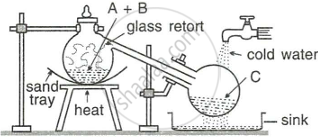Advertisements
Advertisements
प्रश्न
Write equation for the following conversions A, B, C and D.

उत्तर
A: Copper can be converted into copper nitrate.
\[\ce{Cu + 4HNO3 -> \underset{Cu(NO3)2 + 2H2O + 2NO}\]
B: \[\ce{\underset{Blue crystalline}{2Cu(NO3)2} ->[\Delta] \underset{Black}{2CuO} + 4NO2 + O2}\]
C: \[\ce{\underset{Stronh heating}{2Cu + O2} ->[\Delta] \underset{Black}{2CuO}}\]
D: By reduction
\[\ce{2CuO + C ->[\Delta] 2Cu + CO2}\]
APPEARS IN
संबंधित प्रश्न
Write a balanced chemical equation for the following:
Action of cold and dilute Nitric acid on Copper
Name the gas evolved when the following mixtures are heated:
Sodium Nitrite and Ammonium Chloride
Write a balanced equation and name the products formed when cupric oxide reacts with nitric acid.
How will you prepare the following from nitric acid?
Magnesium nitrate
Name the following :
Gas produced in air during lighting.
Name the Following:
Gas obtained by treating manganese with 1% nirtric acid.
Give two chemical tests for nitric acid.
Write the equation for the laboratory preparation of nitric acid from potassium nitrate and concentrated sulphuric acid.
Balanced equation of oxidation of carbon with concentrated HNO3
The figure given below illustrates the apparatus used in the laboratory preparation of nitric acid.

- Name A (a liquid), B (a solid), and C (a liquid). (Do not give the formulae).
- Write an equation to show how nitric acid undergoes decomposition.
- Write the equation for the reaction in which copper is oxidised by concentrated nitric acid.
